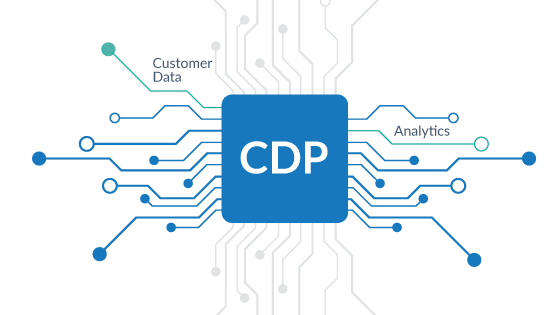Customer Data Platforms (CDPs) have experienced exponential growth in 2020. The number of companies that have deployed a CDP in 2020 compared to previous years has almost doubled, and according the the 2020 CDP Report, 73% of companies surveyed say that a CDP will be a critical component of their customer experience efforts going forward (1).

Customer Data Platforms (CDPs) have experienced exponential growth in 2020. The number of companies that have deployed a CDP in 2020 compared to previous years has almost doubled, and according the the 2020 CDP Report, 73% of companies surveyed say that a CDP will be a critical component of their customer experience efforts going forward. (1)
A Customer Data Platform is a central hub through which all of your company’s customer experience data is processed. Think of it like Grand Central Station for data. Just like people (data points) arrive at the station from many different modes of travel and move from there in many different directions, a CDP organizes, categorizes, and then distributes all kinds of data to keep your company flowing smoothly. Good, usable data is the key to growth, and a CDP is the best way to obtain, compartmentalize, and package that data to be accessed efficiently.

As David Raab of the CDP Institute put it, “Customer Data Platforms are packaged software that helps companies solve a huge and growing problem: the need for unified, accessible customer data. … With careful planning, a CDP will provide the foundation your company needs in the years ahead to meet customer expectations for exceptional personalized experiences.” (2)
With customer touchpoints becoming more and more fractured, an omnichannel solution is non-negotiable. So how can a CDP future-proof your tech investment by growing with your company and keeping pace with inevitable customer data proliferation? First, as an essential tool for not only your marketing department, but all areas of your company, including executive departments, products, and engineering teams; second by streamlining collection and access to eliminate redundancies within your company; and third, by being a flexible, customizable solution for current data sources and marketing goals, as well as future ones.
Also read our post 'Choosing the Right CDP for You'.
Who Benefits from a CDP?
Marketing
By incorporating customer data from all of the many sources where a customer engages with your company, a CDP helps marketers by finely tuning the customer experience, tracking behavior and accurately measuring cost per conversion. Because a CDP can pull customer analytics from so many sources, advertising and email campaigns can be highly targeted, and almost immediately responsive to customer behavior. Not only can marketers build better, more customized advertising audiences, but they can better track the results of each unique marketing effort to build on those results and improve future returns.
Executives
Executive teams are relying more and more on marketing departments to drive growth and determine priorities. With accurate and timely data about the customer journey provided by a CDP, executives can better define priorities and make data-driven decisions for company strategy. Executives want a full-picture view of the customer in order to plan for growth, and that understanding is made possible with a CDP.
Product and Development
Legacy systems and data silos are a huge problem for companies, especially when it comes to scaling for growth. With a CDP, data can be accessed, combined, and streamlined for analytics and measurement of KPIs. For Product departments, a CDP allows teams to draw on relevant customer data to plan for development, and more importantly, provides an efficient means of running tests and tracking results to cut down development timelines.
Engineering
A CDP simplifies the job of your company’s engineering department because they can use one API to deliver all analytics from the CDP. Rather than creating a from-scratch solution for each new data challenge that comes up, using a CDP unifies all the relevant data and makes it deliverable with speed and accuracy. You’re not wasting software engineering time on redundant tasks, and engineers have the capability to create more customized data solutions in a more compressed timeframe.
Efficiency
We all know how difficult it can be to ensure frequent and relevant communication between departments within a company. With different projects and objectives, it can be hard for department heads to keep a big-picture mindset and seek out opportunities for collaboration. What often ends up happening is a duplication of efforts between departments, especially when it comes to data collection and usage. When companies don’t have an efficient way to share data between departments and repurpose customized software, time and money is wasted.
By using a CDP to centralize all of your company’s data, you create operational efficiency that becomes second nature as your company grows. IT departments can easily monitor governance and provide needed access to data resources without investing undue time in providing a unique solution for each department or team’s needs. Furthermore, collaboration becomes simplified when all departments have access to the same data. A CDP simply makes sense for efficient growth.
Preparing Now for the Future
It can be a headache to research all of the options for refining your customers’ experience, and that headache compounds when marketers are tasked with predicting the future. How can you know that your tech investment will pay off in the years to come, especially as the data landscape is changing at an ever-increasing rate?
In addition to the many data management solutions that a CDP can provide in the short term, one of the greatest assets a CDP offers is the ability to adapt and grow with the future needs of your company. With the ability to bring in information from practically any source your company currently uses or may adapt to in the future, a CDP is an elastic tech solution. While we don’t know the specifics of what sources and uses your company will have for customer data in the coming years, it’s safe to say that a CDP will translate that data into actionable information for all of your company’s departments.
Without a crystal ball, it’s a bold claim to make that your company is future-proofed. However, you can have realistic confidence in the ability of your CDP to continue as the hub for your company’s data into the future, and for your ability to track your customers’ journeys to improve with time. There’s no need to fear CDP technology becoming obsolete, as it adapts and changes with the data sources that evolve, bringing you peace of mind and maximizing your tech investment.
Conclusion
Investing in a CDP now means getting a strong return for marketers as well as all other departments. It creates efficiency between departments and allows for future growth without the need to start from scratch as new technology arises, making it a wise investment to meet your company’s needs now and into the future.
(1) https://segment.com/blog/cdp-report-2021/
(2) https://tealium.com/resource/fundamentals/what-is-a-cdp/

